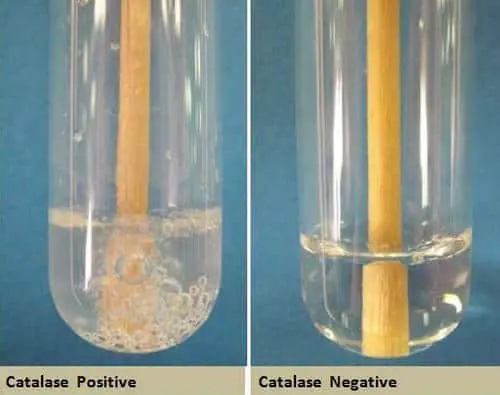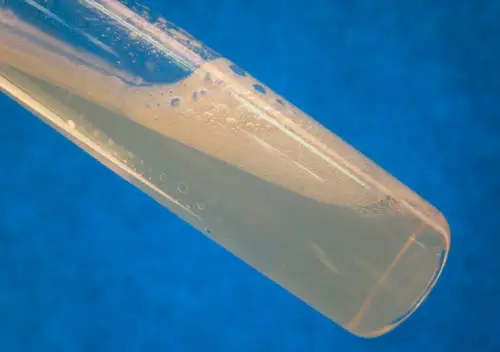What is Catalase ?
Catalase is an enzyme produced by microorganisms that live in oxygen-filled environments to protect themselves from the oxidative damage of hydrogen peroxide (H2O2).
Hydrogen peroxide is a by-product of cellular respiration in microorganisms that utilize oxygen. Catalase hydrolyzes hydrogen peroxide into water and oxygen, which are nontoxic.

Image 1: The reaction catalyzed by catalase.
Picture Source: brilliantbiologystudent.weebly.com
Picture Source: brilliantbiologystudent.weebly.com
Microorganism that are catalase-positive include obligate aerobes and facultative anaerobes. They have the ability to use oxygen as the final electron acceptor. Obligate anaerobes or facultative anaerobes that only ferment and do not use oxygen as the final electron acceptor are catalase-negative.(2, 3)
Purpose of Catalase Test
Catalase test is done to determine the presence of catalase in microorganisms. The test can aid in the identification and differentiation of different microorganisms.
More specifically, the test is used to:
- Distinguish the morphologically similar Gram-positive cocci – Staphylococcus species (catalase-positive) from Streptococcus species and Enterococcus species (catalase-negative)
- Distinguish the Gram-positive spore-forming bacilli – the aerotolerant Clostridium species (catalase-negative) from Bacillus species (catalase-positive)
- Differentiate aerobes (catalase-positive) from obligate anaerobes (catalase-negative)
- Identify and differentiate bacteria in the Enterobacteriaceae family
- Identify Mycobacterium tuberculosis using a semiquantitative catalase test
- Determine the virulence of bacteria(2, 3, 4, 5)
Principle for Catalase Test
Catalase hydrolyzes hydrogen peroxide into water and oxygen gas, which is demonstrated by the immediate formation of bubbles (fizzing).
The presence of catalase in a microbial colony is evident when bubbling of oxygen occurs upon an inoculum’s contact with hydrogen peroxide. The absence of catalase is evident when there is no or weak bubble production upon exposure to hydrogen peroxide.(4)
Procedure for Catalase Test
There are many variations of the catalase test. The methods discussed here are the slide method, tube method, and tube (slant) method. Other methods such as the semiquantitative catalase test for the identification of Mycobacterium tuberculosis, the heat-stable catalase test for differentiating Mycobacterium species, the capillary tube method, and the cover slip method are not elaborated here.(5)
Slide Method/Drop Method
- Using a sterile inoculating loop or sterile wooden stick, get a small amount of an 18- to 24-hour old microbial colony, and place it on the clean, dry glass slide.
Avoid picking up any agar, especially if using agar that contains red blood cells. Red blood cells contain catalase, and would yield false-positive results.
- Using a dropper, add a drop of 3% hydrogen peroxide to the bacterial colony on the microscope slide.
- Observe immediately for the formation of bubbles. Placing the slide against a dark background facilitates easier observation.(5)

Picture 2: Slide method for catalase test.
Photo Source: www.asmscience.org
Photo Source: www.asmscience.org
Tube Method
- Add 4 to 5 drops of 3% hydrogen peroxide to a test tube.
- Using a wooden applicator stick, get a small amount of an 18- to 24-hour old microbial colony, and place it in the test tube.
Avoid picking up any agar, especially if using agar that contains red blood cells.
- Observe immediately for the formation of bubbles at the end of the wooden applicator stick. Placing the test tube against a dark background facilitates easier observation.(5)

Photo 3: Tube method for catalase test.
Image Source: microbeonline.com
Image Source: microbeonline.com
Tube (Slant) Method
- Add 1 mL of 3% hydrogen peroxide to an 18- to 24-hour old microbial culture grown on a nutrient agar slant.
- Observe immediately for the formation of bubbles. Placing the test tube against a dark background facilitates easier observation.(5)

Image 4: Positive result of slant method for catalase test.
Picture Source: www.asmscience.org
Picture Source: www.asmscience.org
Hydrogen Peroxide Concentration
- For routine testing of aerobes, 3% hydrogen peroxide is used.
- For testing of anaerobes, 15% hydrogen peroxide is used. In this case, catalase test is used to differentiate Clostridium and Bacillus species.
- For identifying the different Neisseria species using the Superoxol test (a test similar to the catalase test), 30% hydrogen peroxide is used.(2, 3, 5)
Quality Control of Catalase Test
Positive Control: Staphylococcus aureus
Negative Control: Enterococcus faecalis(4, 5)
Result of Catalase Test
Positive Result: immediate and abundant bubble formation
Examples:
- Routine testing using 3% hydrogen peroxide: Staphylococci, Micrococci, Listeria, Corynebacterium diphtheriae, Burkholderia cepacia, Nocardia, members of the Enterobacteriaceae family (Citrobacter, Escherichia coli, Enterobacter, Klebsiella, Shigella, Yersinia, Proteus, Salmonella, Serratia), Pseudomonas, Mycobacterium tuberculosis, Aspergillus, Cryptococcus, and Rhodococcus equi
- Using 15% hydrogen peroxide: Bacillus species(2, 3, 5)
- Superoxol test using 30% hydrogen peroxide: Neisseria gonorrhoeae(8)
Negative Result: no or scant bubble formation
Examples:
- Routine testing using 3% hydrogen peroxide:Streptococcus and Enterococcus species
- Using 15% hydrogen peroxide: aerotolerant Clostridium species(2, 3, 5)
- Superoxol test using 30% hydrogen peroxide: Other Neisseria species and Moraxella catarrhalis(8)
Catalase and Bacterial Virulence
A host infected with bacteria produces phagocytes and neutrophils to fight against the infection. These cells produce peroxide to kill the bacteria. The enzyme NADPH oxidase produces superoxide within the phagocyte, which is converted through hydrogen peroxide to other oxidizing agents, such as hypochlorous acid, to kill pathogens.
Bacteria that produce catalase are able to deactivate peroxide that are produced by phagocytes and neutrophils. Consequently, these bacteria can resist the killing action of phagocytes, and survive unharmed in the human host.(1)
Precautions for Catalase Test
- Always practice strict aseptic technique.
- If possible, perform the catalase test in a biosafety cabinet.
- For microorganisms grown on blood agar plate, be careful not to pick up any of the blood agar. Red Blood cells contain catalase and would yield a false positive test.
- Microbial culture should be 18 to 24 hours old.
- Hydrogen peroxide must be freshly prepared because it is unstable. It must be stored in dark colored bottles and refrigerated, to prevent decomposition.
- An iron wire inoculating loop must not be used because it would react with hydrogen peroxide, and yield a false positive result.
- Some bacteria produce peroxidase, an enzyme that converts hydrogen peroxide into water.
- It causes a very weak positive reaction (a few bubbles formed after 20-30 seconds). This should not be considered as a true positive result.(2, 3, 5)
References:
- https://en.wikipedia.org/wiki/Catalase#Interactions
- https://microbeonline.com/catalase-test-principle-uses-procedure-results/
- http://www.asmscience.org/content/education/protocol/protocol.3226
- http://microbesinfo.com/2013/05/catalase-test-a-test-to-differentiate-staphylococcus-and-streptococcus/
- https://microbiologyinfo.com/catalase-test-principle-uses-procedure-result-interpretation-with-precautions/
- http://learn.chm.msu.edu/vibl/content/catalase.html
- https://www.ncbi.nlm.nih.gov/pmc/articles/PMC272120/
- http://microbesinfo.com/2016/04/superoxol-test-rapid-presumptive-test-for-neisseria-gonorrhoea-gonococcus/
- https://en.wikipedia.org/wiki/Clostridium
- https://microbeonline.com/key-biochemical-methods-used-to-distinguish-mycobacterial-group/




No comments:
Post a Comment
Due to the high number of spammy comments we have decided to initiate comment moderation so that we can maintain our quality standards and make good environment for our visitors. Please leave your comment